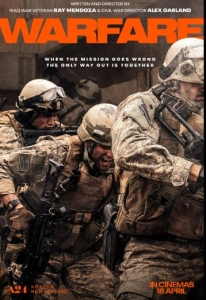 Genre – War Film (based on True Story)
Genre – War Film (based on True Story)
Time: 1 Hour 35 minutes
Platform: Theatrical release
Director: Alex Garland. Ray Mendoza
The Iraq war and Afghan war movies are like a cottage industry with predictable plots. Mostly the plots are about ‘decent’ Americans caught in a situation and – usually – surrounded by faceless ‘bad guys’ who keep shooting at them from everywhere. They must desperately hold on while their numbers start decreasing due to injuries or deaths. They can’t be safely extracted from the location and use of air power is difficult for fear of a ‘blue on blue’ incident. So, they fight valiantly, till help arrives and they are all extracted back to their operating base.
Variations of this plot have been there for the last 20 plus years. One such film is The Outpost which I had reviewed on February 18,2023. There are many more movies like this; Lone Survivor (2013) is yet another example. Some even term it as Iraqi / Afghan war porn movies where the emphasis is on the guns, the explosions, the swearing and the enemies being blown up in droves. There is never a remote mention of the causes or even why the soldiers are there.
They are all doing their duty. Period. In other words, shamelessly propagandist (as will be seen in what happens to the locals caught in the crossfire).
Warfare is one more among the cottage industry of Iraq war movies. However, it is exceptionally and even brutally well made, without any of the typical cliches that are used in war films. Eg – soldier remembering his girlfriend or home life is the first one to die in a brutal way.
The cliches are not necessary as these are not soldiers but US Navy Seals who are in the larger public imagination ten feet tall. Here, they do prove that they are ten feet tall in the way they manage the fight. What leads to the fight and the fight itself is what forms the crux of the film.
Ramadi, 2006. A SEAL Platoon enters the home of an Iraqi family and turn their home into a fortified observation post. The terrified family are kept in one room and one of their walls, overlooking a local mosque, is demolished and the mosque is observed through that hole. The ‘enemy’ also observe them. They can see that ‘MAM’s – Military Age Males – are getting together in the area and repeatedly surveying their post. Sure enough, grenade is dropped through the hole of the observation post and the sniper who has been observing them is slightly wounded. The firefight starts. The position is surrounded. Their calls for backup go unanswered as the area is swarming with ‘bad guys’. Their Iraqi interpreters are killed by an IED. The pressure mounts and the team starts losing soldiers one by one with many seriously wounded. What happens and how the team is extricated forms the rest of the film.
The terrified Iraqi family forms the perfect metaphor for the entire situation – Americans coming inside their home, knocking down walls, blowing up things outside their property, and then finally leaving a mess in the area and the surrounding buildings. After the Americans leave, they tentatively and hesitantly come out of their home and look at the surroundings. The ‘insurgents’ , whose affiliation is not defined, too come out and look at the areas, just vacated by the Americans.
It is also an indicator of how the Americans fought – in Vietnam, Afghanistan, Iraq. Take an area, clear it of ‘bad guys’ Declare the area safe. Go back to their operating bases. The bad guys re-occupied the area vacated by the Americans. And in some cases, repeat the task all over again.
So, is the film any good? Of course; it is an exceptionally well-made film that doesn’t skimp on the blood, dust and gore.
It is a good example of that old saying ‘war is hours of boredom followed by moments of sheer terror’. Despite its total glorification of the American effort, as a war film, it is still excellent.
Real History – 4 out of 5
Script – 4 out of 5
Story – 4 out of 5
Direction – 4 out of 5
Production Design – 4 out of 5
Total – 4 out of 5
Nice!